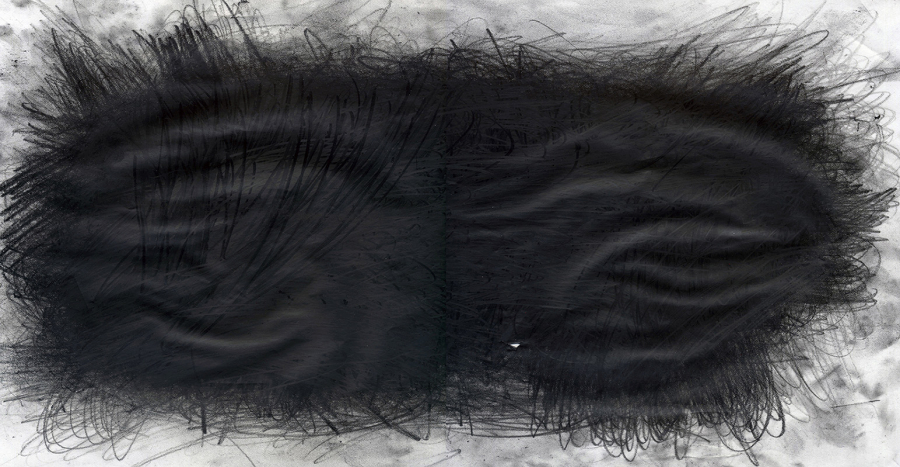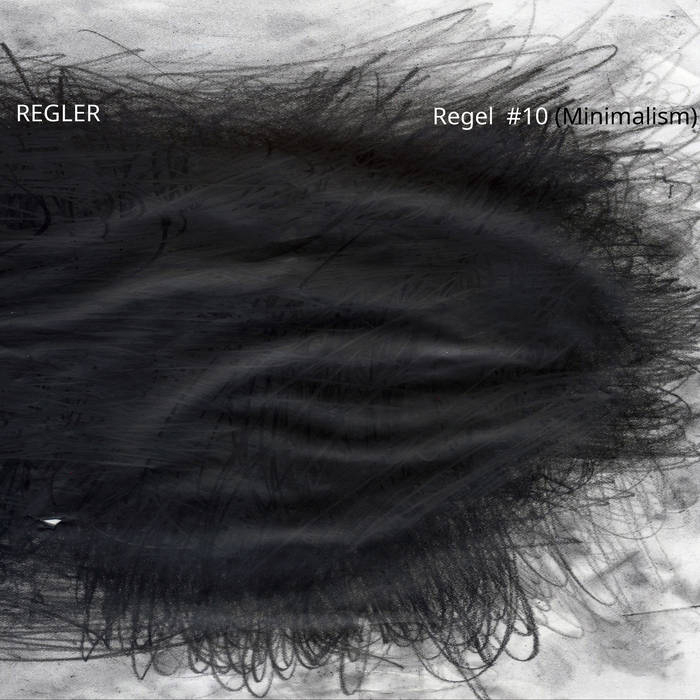
REGLER, regel #10 (Minimalism)
CD+booklet
Seminal Records Brazil / Berlin
_______________________________________________________________________
DM 150 SEK + shipping
_______________________________________________________________________
Following Discogs Minimal Music Description:
Minimalism has an aesthetic which can be summarized as "less is more", like cold-wave bands looking for an empty sound in the 80's.
When used by itself, it generally denotes music that uses only one instrument, without complex layers. Usually no vocals layer.
Regler is dedicated to investigating critically the tropes of our current musical genres. In this record they delve into minimal or minimalism.
’It opens with the sound of drawing. Monotonous, uninterrupted.
Sometimes the hand changes direction, perhaps when wrists start aching. Then you hear fractured, raw guitar struck with pencil instead of a pick and a drum hit and draw upon with a pen. Sometimes they are indistinguishable from one another or from the sound of drawing and sometimes you hear them changing places in the foreground. The question I believe Regler answers is: ”What happens if you take silence out of drawing?”.
Two formal aspects seen to conceptually bind together the two elements of Regler’s performance, the acoustic amplification of drawing and it’s trapping among rock instruments.’
@andrei_chitu
Andreas Soma: pencil, contact mic
Anders Bryngelsson: pencil, snare drum, effects
Mattin: pencil, guitar
Recorded by Mattin at Mädchenkammer, Berlin, 11 noevember 2017
Mastered by Rashad Becker at Dubplates & Mastering, Berlin
Photos by Irene Gellein
Text by Andrei Chitu
Thanks to David Bremner and Crispin Gurholt
Anti-Copyright
Released August 29, 2023
Seminal SR #88: Regler - Regel #10 (Minimalism)
_______________________________________________________________________
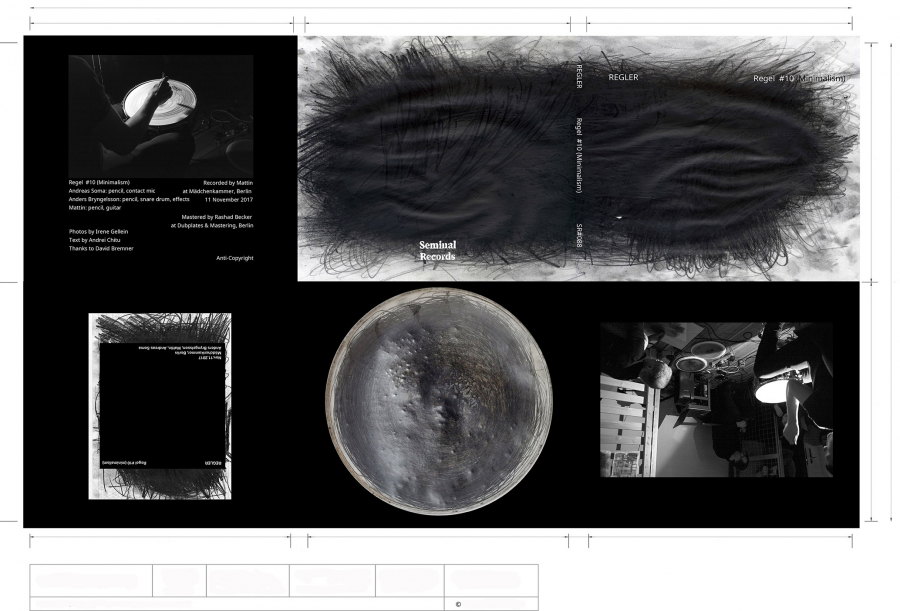
---------------------
Vital Weekly
---------------------
number 1384
---------------------
week 17
---------------------
I forgot all about Regler, the group consisting of Mattin, Anders Bryngelssson and (guest player) Andreas Soma. They all play pencil, along with (in order) guitar, snare drums & effects, and a contact microphone. They "set up rules and try to do different genres of music with rock instruments". They already covered dub, free jazz, harsh noise or blues. That last one, reviewed in Vital Weekly 1093, was the last I heard from time. They pop up again, albeit with older recordings, as we will see, with their take on 'Minimalism' and 'Ambient'. There is no explanation for the latter, but reading (trying to) about the first in the booklet, gave me a mild headache, with its highly complicated art world talk. There is not much minimalism there. Drawing with a pencil slips in there somewhere in the text, and that might explain the use of pencils in the music here. The record made at the Mädchenkammer in Berlin is already from 2017. The forty-five minutes this work lasts is a strange affair of amplified acoustic sounds, non-rhythmic snare drums sounds, some kind of electronic sound and, yes, a very minimal approach. Not in terms of Steve Reich (et al.) and his minimalism, but more as in 'there isn't much happening in terms of development', but changes, as always, even with minimalism, take place. Perhaps fatigue and strains play a role, thanks to the hands playing this. 'Minimalism' becomes a ritual in that way—strangely compelling music. FdW
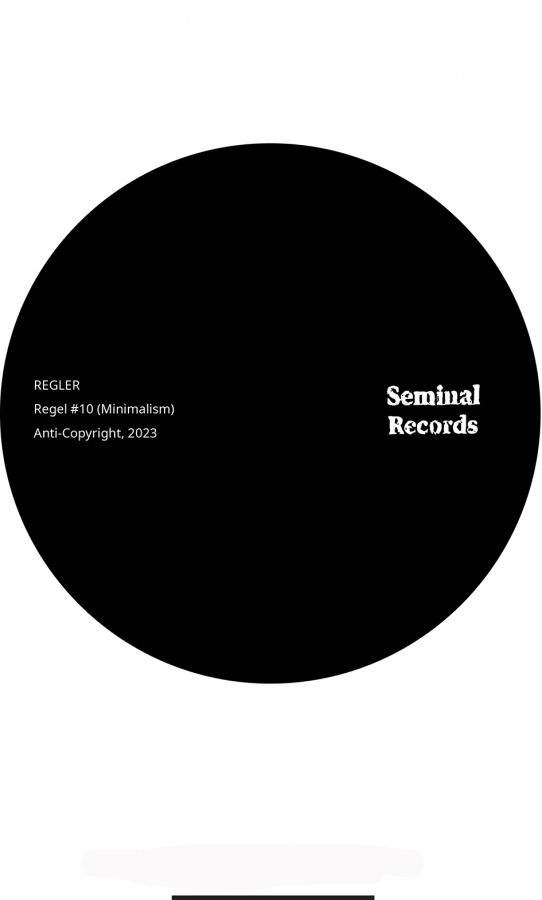
Bad Alchemy April 2023
Seit 10 Jahren führen der Drummer Anders Bryngelsson (Brainbombs, No Balls, FCOC, Orchestra Of Constant Distress) und Mattin an Gitarre mit radikalem Ansatz eine Testreihe formaler Regeln der Musik durch: Speed & Power (#1), Free Jazz (#3), Harsh Noise (#4), Classical Music (#5), Techno (#6), Drone (#7), Metal (#8), Blues (#9), No Wave (#11). Der aus Stavanger stammende Künstler ANDREAS SOMA, ihr Kollaborateur bei Regel #10 (Minimalism) (Seminal Records, SR#088), beschreibt das so: Bei Regler geht es einfach darum, eine Reihe von Einschränkungen, Rahmenbedingungen und Regeln zu erstellen, nach denen Sie arbeiten. Sie können Ton vom Zeichnen mit Kontaktmikrofonen verwenden oder physisch so lange und so hart spielen, wie sie es ertragen können, oder überhaupt nicht spielen und den Ton davon aufnehmen. #10 haben sie 45 Minuten lang mit Stiften auf Papier, Holzbretter, Snaredrumfell und E-Gitarre gezeichnet, es mit Kontaktmikrofonen aufgenommen und durch verschiedene Synthesizer, Filter und Pedale gemischt. Soma hat sich bereits mit „Grand Excelsior Principi di Savoia Tubus“ (als barocker Umschreibung für '24 Röhren') als hörender Künstler erklärt: Ölpipelines sind Geld und Kapital und die wirtschaftliche Grundlage für Stavanger und Norwegen. Rohre sind auch Konflikt und Gewalt, wie eine Bombe, Kanone, Pistole oder ein Gewehrlauf. Sie sind der Körper, die Blutgefäße und das Darmsystem, Klänge wie Blasinstrumente, Orgel, Trommel und Sirenen. Penis und Scheide. Ich fing an, eine Theorie zu entwickeln, dass alles Pfeifen sind. Seine Klangzeichnungen als Coverkunst verraten ebenso die Intensität des Projekts wie 'On Regler's Minimalism' als essayistische Resonanz des Philosophen Andrei Chitu. Mit Thesen wie: The abolition of silence is the minimalism of art that Regler has in mind... [It] shows itself to be the opposite of what one usually takes the minimalist credo to be, namely the avoidance of clichés and other redundancies at all costs, even if it means vacuity or a white canvass... [The sound of drawing] produces anxious contemplation as the intellectual form of social paralysis and its noise is the self-distortion of a social reality minimalistic in itself. Nach Chitu ist man mit Somas wetzenden Schraffuren, Bryngelsson monotonem Klopfen oder Schaben und Mattins Tupfen und Pochen mittendrin in den rauschenden Ambiguitäten und Aporien von Form, Inhalt, Transgression, Indeterminacy und damit einer Wahrnehmungsmöglichkeit von dem, was Mattin 'soziale Dissonanz' nennt. [BA 119 rbd]
_______________________________________________________
_______________________________________________________
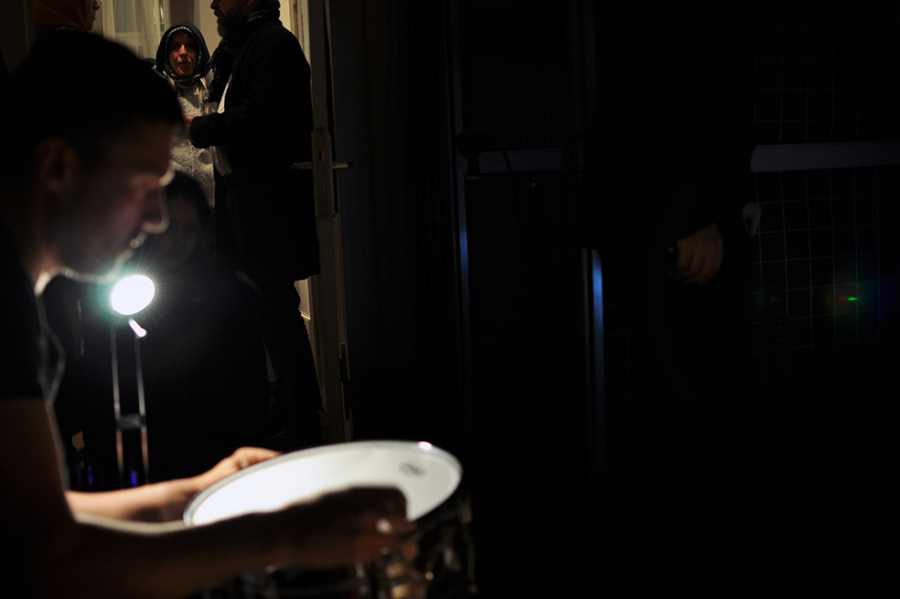
Reviews
MINIMALISMORE Jesús Rodríguez Lenin 09/07/2023:
Regler is an experimental music and improvisation duo formed ten years ago by the Swedish Anders Bryngelsson and the Spanish artist, guitarist and composer Mattin. They have recently released on the Brazilian label Seminal Records "Regel#10 (Minimalism)", a 45:39 minutes long piece recorded on 11 November 2017 at the Mädchenkammer in Berlin. The album is a conceptual vision of minimalism: don't expect to hear reminiscences of Glass, Reich, Young or Riley. Here we hear, above all, the sound produced by drawing with pencils on different surfaces: paper, wooden boards, the snare drum or an electric guitar, recorded with contact microphones and mixed through various synthesizers, filters and pedals.
Almost six years after its recording, “Regel #10 (Minimalism)” by the Spanish-Swedish duo Regler is released.
In the avant-garde world, obscurity is almost the norm. Tracking down interviews, articles or album reviews/comments is an odyssey, and if you manage to find a website near you, you don’t manage to scrape much more information either. When I get the CD of Regel#10 (Minimalism), a single 45:39-minute piece created by Regler, I see that it’s a relatively old recording, from 11 November 2017, made in Berlin’s Mädchenkammer (actually a centrally located pension in a historic 19th-century building). Regler is a duo of experimental music and improvisation formed ten years ago by the Swedish Anders Bryngelsson – drummer and percussionist in Brainbombs, Orchestra of Constant Distresss, No Balls, among other groups – and the Spanish artist, guitarist and composer Mattin – member of bands like Billy Bao or Josetxo Grieta. Throughout the numerous albums they have released over the years, they have sometimes had isolated collaborations with musicians such as Henrik Andersson (Bryngelsson’s partner in Orchestra of Constant Distress), Yoann Durant, Dario Fariello, Seth Kim-Cohen and Andreas Soma, among others.
Several of Regler’s albums, all titled as Regel# and a correlative number, are subtitled in brackets: Dbeat, Noise Core/Free Jazz, Harsh Noise Wall (HNW), Classical Music, Metal, Techno, Blues, No Wave, Ambient… which are, effectively, “their” approaches to each of these genres, as can be seen in a quick check on their bandcamp. I’ll break it down for the uninitiated: nobody should expect “classical music”, “blues” or “ambient” on these albums. They are, in any case, experimental and very free deconstructions of each other, the “interpretation” of two noise musicians of the different concepts of musical genre. There is more closeness, however, in their approaches to different versions of metal, No Wave or HNW: they are situated in the orbit of noise and the unassimilated avant-garde, i.e. the terrain in which the work of Regler and, in particular, of Mattin himself, author of an artistic/musical project with which he participated in 2017 in documenta 14, entitled Social Dissonance, which he later expanded with an extensive essay of the same title, and in which one could read that “noise had become a musical genre with specific tropes – high volume, aggressive frequencies, etc. – and that it was gradually becoming a parody of itself”.
And now we come to Regel#10 (Minimalism). And I’m disengaging: don’t expect recreations of Philip Glass or Steve Reich, or even the more static sounds of La Monte Young or Terry Riley: the minimalism referred to here, in which Norwegian Andreas Soma participates as guest musician, is another philosophical deconstruction of the genre that has been most perversely desecrated in the realm of culture. As the Romanian philosopher Andrei Chitu says in the booklet accompanying the album, minimalism is “the early victim of its own success, as perhaps none of the ‘-isms’ has been more abused and touched by terminological decay”. He further advances that “Minimalism’s relation to form seems to be the interest of the implicit theory found in Regler’s Minimalism, one that could draw a sharp critical edge against some bad habits of the recent and not so recent avant-garde”.
Regel#10 (Minimalism) challenges us with another conceptual meaning of minimalism. Here we hear, above all, the sound produced by drawing with pencils on different surfaces: paper, wooden boards, the snare drum or an electric guitar, recorded with contact microphones and mixed through various synthesizers, filters and pedals. There is also a very simple and monotonous rhythmic pattern and Fred Frith-like guitar strumming. Indeed, it all comes across as monotonous and minimalist, even noisy – in the sense of inarticulate, not “unpleasant”, as no unhealthy frequencies are used – and should be considered more as an exercise in conceptual music, perhaps not as extreme, philosophically speaking, as Cage’s 4’33”, but close to Wolf Vostell’s Fluxus action music – Take the PC-Petite Ceinture bus in Paris and be really attentive during the four-hour journey to everything audible – or to Yves Klein’s Symphonie Monoton-Silence, works that stand on their own merits as the most accurate antecedents of a certain way of understanding minimalism.
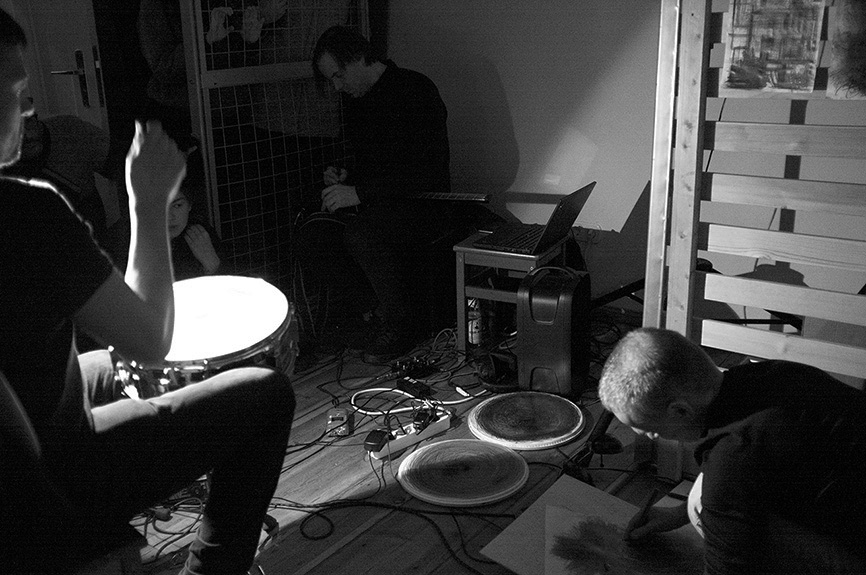
Regler, Live at Mädchenkammer Berlin. Performance in collaboration with IASPIS, the Swedish Arts Grants Committee´s International Programme for Visual and Applied Arts.
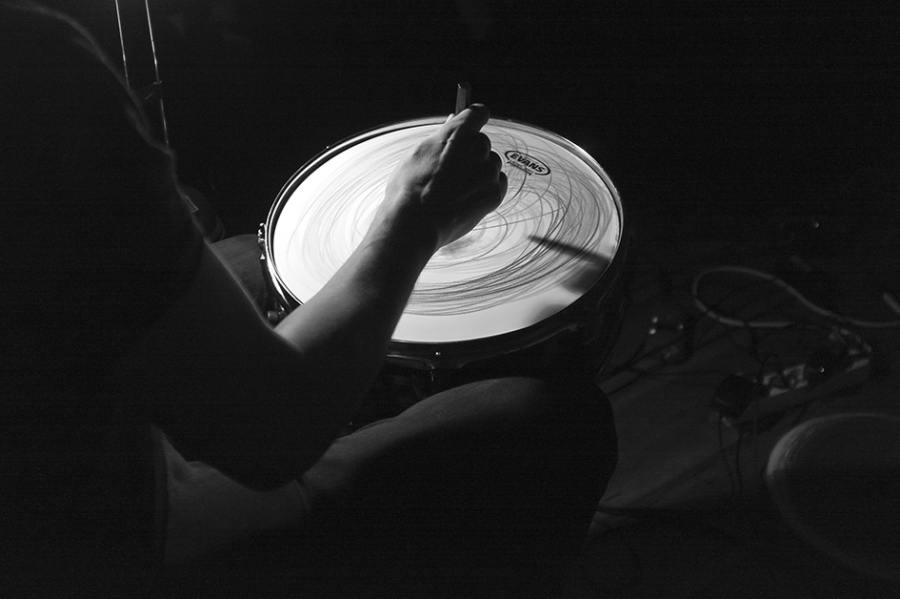
__________________________________________
__________________________________________
Regel #10 by the band Regler is an exercise in minimalist deconstruction of musical sounds and forms. It consists of one track about 45 minutes long. Three musicians form the ensemble. One plays a guitar with a pencil, one hits a contact mic with a pencil, and one hits a snare drum with a pencil’s eraser. The sound of a pop from the drum is heard regularly every three to four seconds. The word régler in French means “adjust.” In German, it means “regulator,” and in Danish/Swedish/Norwegian, it means “rules.” What is being regulated and adjusted is the set of rules of a musical form. In this piece, a form that is something like an instrumental movement has been reduced to the noise of guitar strings, the drum, and a microphone pickup with a monotone beat. Listen to this work if you’re up for a challenging, surprisingly contemplative mix of waves and beats.
__________________________________________
__________________________________________
Ox Fanzine / Ausgabe #171 Dezember 2023/Januar
Diese Band könnte entweder das spannendste oder das anstrengendste Duo der Musikgeschichte sein. REGLER sind Brajan von BRAINBOMBS und Mattin, die es sich zur Aufgabe gemacht haben, sich einer Vielzahl von Genres zu widmen – von Klassik über Grindcore hin zu Techno, je nach bestehender Regel. „Regel #10 (Minimalism)“ muss man tatsächlich als eine Stilübung begreifen, denn aus den instrumentalen Gegebenheiten zu so etwas wie Wohlklang oder Harmonie zu kommen, ist schlicht nicht möglich. Der Minimalismus-Schnappschuss ist bereits 2017 in der Pension Mädchenkammer in Berlin aufgenommen worden. Das Klangbild auf dem Album, dessen Veröffentlichung ein brasilianisches Experimental-Label übernimmt, ist geprägt von Bleistiften, die in losem und fortwährendem Kontakt zu den eigentlichen Instrumenten stehen (Gitarre, Kontaktmikrofon und Snare Drum). Eine:r muss es ja mal ausprobiert haben.
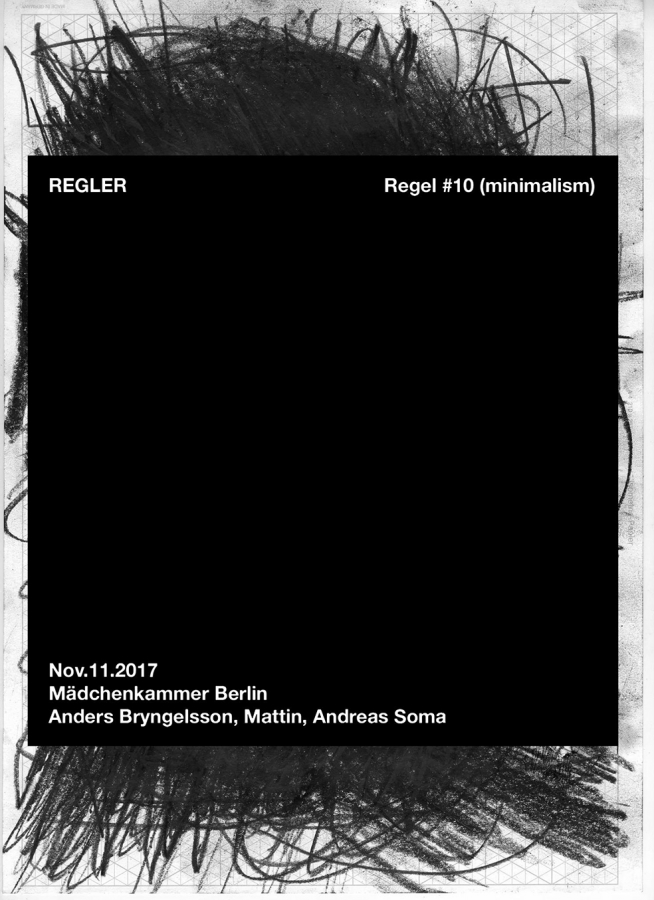
Poster for Mädchenkammer, screenprint by Kjetil Brandsdal /Drid Machine
__________________________________________
__________________________________________
Andrei Chitu
ON REGLERS’ MINIMALISM
If the purpose of the avant-garde is to, at least, stave off material or terminological decay and combat ossification, then it has to battle nowadays not only sediments cluttering contemporary consciousness but also some of its’ own progenies left behind in the race to the bottom of reflection or those disqualified by the obsession with purity of practice. Minimalism was one of the names of these original impulses of the avant-garde, the early victim of its’ own success, as perhaps none of the “-isms” has been more abused and touched by terminological decay than “minimalism”.
If there are entire book shelves of motivational literature and fitness guides that qualify some of the dumbest forms of conspicuous consumption as “minimalist”, one might forgive the avant-guards’ fall to the temptation of leaving it aside and start (again) an optimistic as well as panicked search for the New.
The disorder of things plaguing the usage of the term “minimalism” originates in its’ broad employment as a signal for a theoretical point about form and abstraction. Form and abstraction themselves are rusty concepts on eroded foundations that carry a somewhat disreputable past, in some contemporary circles.
Minimalisms’ relation to form seems to be the interest of the implicit theory found in Reglers’ Minimalism, one that could draw a sharp critical edge against some bad habits of the recent and not so recent avant-garde.
Form, generally, has a certain dubious kind of existence that can be grasped only by the awfully equivocal platitude that it is not identical with the content that is bound to it. As such, it is easy to qualify it as “just an abstraction” and to raise questions about its’ reality. Minimalisms’ preoccupation with form stems from the problem that minimalism tries, in principle, to address, which is the decay of content, of its’ diminished expressive power originating from prolonged captivity and abuse in space-time contexts. The atrophy could no longer be hidden under overdoses of technique, but there could be regeneration by engaging form. Because form is complicity.
It opens with the sound of drawing. Monotonous, uninterrupted. Sometimes the hand changes direction, perhaps when wrists start aching. Then you hear fractured, raw guitar struck with a pencil instead of a pick and a drum hit and drawn upon with a pen. Sometimes they are indistinguishable from one another or from the sound of drawing and sometimes changing places in the foreground.
The question that I believe Regler answers is: “What happens if you take silence out of drawing?”.
Two formal aspects seem to conceptually bind together the two elements of Reglers’ performance, the acoustic amplification of drawing and its’ trapping among rock instruments. The first one that comes to awareness is the transformation of the act of drawing in an instrument that produces sounds. A painting in a museum, a graffiti on a wall, a poster in your room is silent. But drawing can be listened to and thus it can be used as a sound, were it not for the inertia of the end-product that silences with its’ presence the process that led to its’ existence.
The formal gesture employed by Regler strips pen and paper bare of their practical qualities and creative ends, as vehicles of intellectual and creative work. This is necessary, as intellectual work, ashamed of its laborious process, strives to keep the guilty appearance of direct monopolistic enjoyment of its creative resources. Transposed in the medium of sound those instruments of creativity are but acoustic surfaces to be worked with. Work that is no longer linked to the purposefulness of objects but a compulsive scratching of surfaces. This work is noise. What has been creative work protected by the complicity of instruments and covered in the silence of the end products became, through a shift of awareness a repetitive, mechanic noise.
This displacement of pen and paper in the realm of sounds, that brackets their use-value by cutting their intrinsic link, implicates further the equivalence of sounds by hammering the pen on surfaces that are or could have been thought as generic musical instruments. This formal equivalence of sounds is the second aspect of Reglers’ theory of form.
If one tries to imply a certain kind of causal temporality between the two aspects, a peculiar dialectic develops. If we start with the transgressive act of reducing objects to their acoustic surface, flattening their other differences we can see the resulting equivalence as its’ product. Form, as seen here, is the institution of differences, of obstacles, of coercion and hierarchies. Its reduction is a negation that radically questions its existence and isolates it from content. Thus (creative) freedom qua indeterminacy is set against form. The “acoustic” exploitation of drawing could be interpreted as an implicit critique of the abstraction incarnated in the institution of music and its’ conventions that abolishes the difference between musical and non-musical elements, as those represent obstacles to the freedom of (artistic) self-expression. Freed from conventions artistic consciousness would be able to engage in new, more direct and more creative ways with its’ matter, unencumbered by form. In our case, the levelling of the field of differences throws the pen in the abyss of choice, setting it free and endowing the responsibility to organise sounds in an innovative way, to bring about the much sought after New. This universal formal equivalence of sounds, the “acoustic liberalism” achieved through transgression, is then the precondition for a new politics of sound.
But starting with the other aspect, the universal equivalence of sounds as a given state of things, all search for the New seems a one-sided exercise in futility. Then all transgressive practice reiterates the fait accompli of an already flattened conceptual space, whose holistic hollowing out leads to a crisis of orientation that evacuates all transparency regarding meaning, of surplus value gained in preferring a certain constellation of sounds over others. What transgression achieves is not the New but boredom, as all critique of institutions happens under the dumb auspices of “why not”.
The problem with this way of thinking about form in this way is its’ inherent ambiguity, ambiguity dat manifests itself in the ambivalence generated by the understanding of freedom as indeterminacy and it’s undialectical opposition to supposedly stultifying form. The, in the end ethical, opposition between the voluntaristic understanding of transgression as act and its’ counterpart, the nihilistic lucidity of seeing transgression as a given self-refutation transforms all discourse about art in a perhaps more elevated form of motivational literature.
This ambiguity is only the symptom of the imposibility of thinking the moebius strip that links artistic practice and social reality, that one could call the complicity of form.
Regler knows that the musician depends on external form, institutions and conventions that create the background of silence on which music happens. The neutrality of silence guarantees the necessary distance between music as art and institution from society and historical context. If the difference between the sound of a musical instrument is equivalent with the sound of a pencil which itself could be exchanged with footsteps, screeching tires, inner monologues, boiling water or the hammering of nails then those sounds are but reverberations of social reality. The abolition of silence is the minimalism of art that Regler has in mind.
If the abolishion of silence, the ubiquitous equivalence of sounds that generates noise is not externally imposed, neutral form, what can it then be? What if the neutral equivalence and formal equality of sounds is their individual redundancy and obsolescence, being thus engaged in the open-ended competition for the attention of the pen? What if noise is form as their self-distortion, their struggle against redundancy? Noise is thus the plurality of sounds competing for musical relevance. That musical equivalence does not turn into consonance is the truth of noise, the redundancy and obsolescence of every sound, it’s self-degradation.
This is brilliantly illustrated by regler in it’s use of classic rock instruments, as the guitar and drum occupy still their place in what would have been a standard rock band but both are pulled into their new role as acoustic surfaces scratched by the pen, creating the tension between the role that made them what they were and the current position in a structure that denies it.
But there is a second aspect of the association of generic musical instruments with the amplified drawing. This association forces the pen to confront the historicity of the musical realm and its’ embededness in the social space. The freedom of the pen is thus never the ex nihilo abyss of spontaneity and creativity but subjected to the same gravity of the materials and their use-value significance that pulls it back into the repetition and recycling of cliches. Thus Reglers’ Minimalism shows itself to be the opposite of what usually one takes the minimalist credo to be , namely the avoidance of cliches and other redundancies at all cost, even if it means vacuity or a white canvass. Regler shows that this common understanding of minimalism is bound to the rather maximalist presupposition that one can abstract, reduce and freely manipulate materials and that cliches are not immanent to (creative) conciousness. As such the artistic subjectivity is the standpoint of silence, with an endless capacity for abstraction. This is ,as Regler well knows the ultimate cliche of intellectual work. The menacing sound of Reglers performance is maybe the unease of the creative worker, say, a copywriter enslaved by its own redundant self-understanding as free and spontaneous reserve of expressive capability.
Abolishing silence as a minimalist act does not mean denying the gravity of the formulaic in the name of form nor does it mean a negation of form, just to find yourself entrapped by the formulaic. The systematic evacuation of silence from drawing means purging all complicit agreement between practice and conceptualisation, two moments that are in fact already dissociated in the endless waste of sonic interference.
That particular sound of drawing that you hear when you think of anything but that what is being drawn. A sound that does not allow concentration coalesce around a coherent shape, and does not enable immersion in the act that it mimics, nor does it permit floating beyond its echo. Instead of liberating the mind by keeping hands occupied, the pen abuses the strings of your consciousness. It produces anxious contemplation as the intellectual form of social paralysis and its noise is the self-distortion of a social reality minimalistic in itself.
[Text from booklet + CD, REGLER, regel #10]
______________________________________________________
______________________________________________________
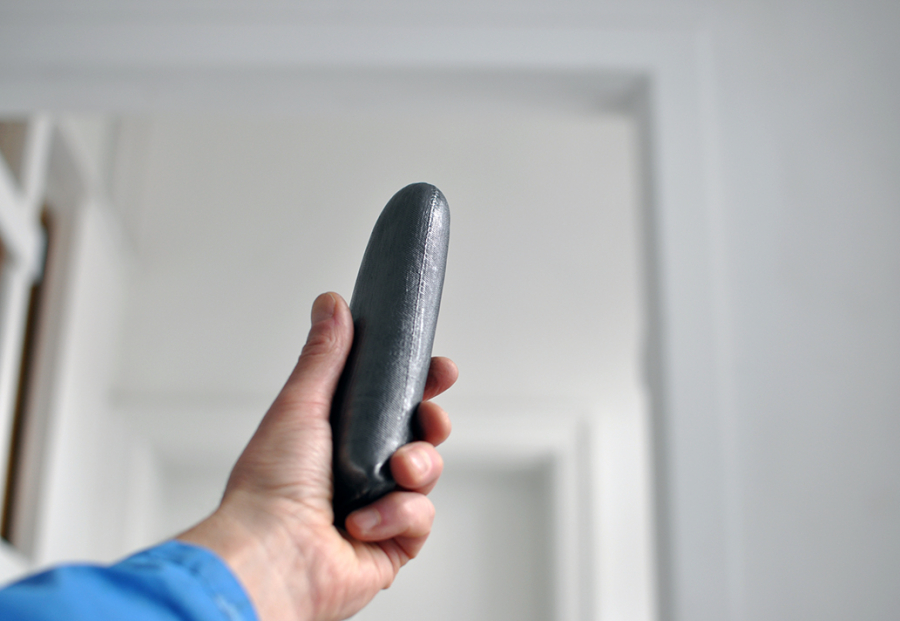
Art Graf XL. Hand Made Water-soluble Graphite Stick
_______________________
Supported by International Program for Visual and Applied Arts

______________________________________________________
